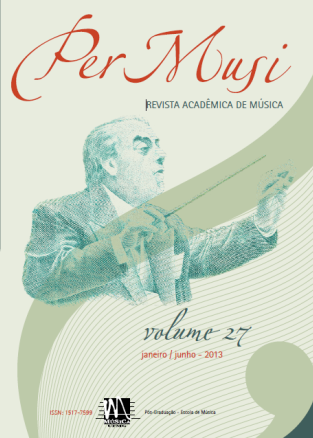Tres perspectivas gestuales para un rendimiento de la percusión
técnica interpretativo y expresivo
Palabras clave:
El gesto en la percusión, El movimiento corporal en la música, El ejercicio intelectual y el rendimientoResumen
Este artículo propone una reflexión sobre la actuación del intérprete percusionista en función de los gestos que puede aplicar en una interpretación musical. Para una construcción performativa, que creemos puede ayudar en la transmisión del contenido musical de una obra, seleccionamos tres acciones gestuales: técnica (relacionada con los movimientos corporales); interpretativa (relacionada con los ejercicios intelectuales) y expresiva (integración de acciones corporales e intelectuales). Las explicaciones y análisis sobre los fenómenos gestuales se ilustran con obras consagradas del repertorio de percusión.
Referencias
ANTUNES-PENA, L. (2011). Três Quadros sobre Pedra. Tübingen: Sumtone.
APERGHIS, G. (1981). Les Guetteurs de Sons. Paris: Editions Salabert.
BAILLEY, B. (1963). Mental and Manual Calisthenics for the Mallet Player. 1º ed. New York: Warner Bros.
BARTÓK, B. (1939) Sonata para dois pianos e percussão. (ed. de 1942) Londres: Wakes & Son.
BERNARD-MÂCHE, F. (1982). Phènix. Paris: Editions Durand.
BLOM, L. A., e L. T. CHAPLIN. (1989). The Intimate Act of Choreography. 1ª ed. Londres: Dance Books Ltd.
BOLÃO, O. (2003). Batuque é um Privilégio 3ª ed. Rio de Janeiro: Lumiar.
CAGE, J. (2007). Silencio. Tradução: M. Pedraza. Madrid: Ediciones Àrdora.
_______. (1939). First Construction (in Metal). New York: Edition Peters.
CAMURRI, A., e T. MOESLUND. (2010). Visual Gesture Recognition. In Musical Gestures - Sound, Movement, and Meaning. Editado por R. GODØY e M. LEMMAN. London: Routledge.
CATALÃO, J. (2008). Le Jeu organique du musicien: Des chemins pour une interprétation vivante en musique. PhD Thesis, Faculté de Musique Université de Montréal, Montréal.
CAZARIM, T. (2008). “Ação, pensamento, gesto, expressividade e a prática musical”. Anais do SIMCAM 4 – IV Simpósio de Cognição e Artes Musicais. .
CHAIB, F. (2007). Exploração Tímbrica no Vibrafone: Análise Interpretativa da Obra Cálculo Secreto, de José Manuel López López. Dissertação de Mestrado, DeCA-Universidade de Aveiro, Aveiro.
DEANE, C (1983). Mourning Dove Sonet. EUA: Edição do autor.
FAZENDA, M. J. (1996). “Corpo Naturalizado: Experiência e discurso sobre duas formas de dança teatral americanas”. In Corpo Presente, treze reflexões antropológicas sobre o corpo. Oeiras: Celta Editora. Delalande, F. (1988). La gestique de Gould. In G. Guertin (Ed.), Glenn Gould: Pluriel, (p.85-111). Montréal: Courteau.
GIL, J. (2001). Movimento Total: O Corpo e a Dança. Lisboa: Relógio D’Água.
____. (1980). Metamorfoses do Corpo. Tradução: M. C. Meneses. Lisboa: A Regra do Jogo, Edições Ltda.
GODØY, R., e M. LEMAN. (2010). Musical Gestures - Sound, Movement, and Meaning. 1ª ed. New York: Routledge.
GRISEY, G (1976). Partiels pour 18 musicians. Milão: Ricordi.
JENSENIUS, A., M. WANDERLEY, R. GODØY, e MARC LEMAN. 2010. Concepts and Methods in Research. In Musical Gestures - Sound, Movement, and Meaning. Editado por R. GODØY e M. LEMAN. New York: Routledge.
LABAN, R. (1978). Domínio do Movimento. Tradução: A. M. B. DE VECHI e M. S. M. NETTO. 5ª ed. São Paulo: Summus Editorial. 1ª ed. McDonald & Evans Limited 1971.
LANG, D. (1991). The Anvil Chorus. Red Poppy.
LANGER, S. 1953. Sentimento e Forma. São Paulo: Perspectiva.
MCNEILL, D. (2005). Gesture and Though. Chicago: University of Chicago Press.
NOBRE, M. (1963).Variações Rítmicas.
OLIVEIRA, J.P. (1993). Kity. Portugal: Edição do autor.
OLIVEIRA, L. (2010). Radio Bossa. Porto: Edição do autor.
PIKE, K.L. (1967). Language in Relation to a unified theory of the Structure of Human Behavior. The Hague: Mouton.
PIRES, (1971). Ostinati. (ed. de 1982).Frankfurt: Zimmerman.
ROSAURO, N. (1992) .Rhapsody for Percussion Solo and Orchestra. Santa Maria: Pro-Percussão.
SCHICK, S. (2006). The Percussionist’s Art: same bed, different dreams. Vol. 1. Rochester: University of Rochester Press.
SEJOURNÉ, E. (1999). Concerto pour Vibraphone et Orchestre à Cordes. Paris: Alfonce Produtions.
STASI, C. (1990). Canção Simples de Tambor. São Paulo: Edição do autor.
TINOCO, L. (2003). Imaginary Dancescape a Melodrumming after Cocteau. Porto: Edição do autor.
TRALDI, C., J. MANZOLLI, e C. CAMPOS. (2009). “Os gestos Incidentais e Cênicos na Interpretação entre Percussão e Recursos Visuais”. Ensaio Magazine, Outubro 2009, 16 - 18.
ZAMPRONHA, E. (2000/2006). Recycling Collaging Sampling. São Paulo: Edição do autor.
ZBIKOWSKI, L. M. (2011). Musical Gesture and Musical Grammar: A Cognitive Approach. In New Perspectives on Music and Gesture. Editado por A. GRITTEN e E. KING. Farnham: ASHGATE.
Descargas
Publicado
Número
Sección
Licencia

Esta obra está bajo una licencia internacional Creative Commons Atribución 4.0.

Excepto cuando se indique lo contrario, el contenido de este sitio está sujeto a una Licencia Creative Commons - Atribuição 4.0 Internacional.












